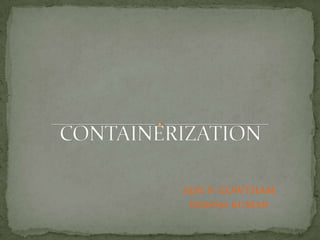
containerization
- 1. AJAY P. GOWTHAM DINESH KUMAR
- 2. Containerization is a modern phenomenon of the last thirty years. The moving of cargo over long distances in a reusable, sealed, standard box by means of a relay between different modes of transport on land and sea. For centuries land transport was hampered by bad or non- existent roads. In 19th century travel by water had became cheaper, faster and more comfortable.
- 3. Although having its origins in the late 1780s or earlier, the global standardization of containers and container handling equipment was one of the important innovations in 20th century logistics. Malcom Purcell McLean was an American entrepreneur, often called "the father of containerization". In 1956, he developed the metal shipping container, which replaced the traditional break-bulk method of handling dry goods and revolutionized the transport of goods and cargo worldwide
- 4. Dry storage container Flat rack container Open top container Tunnel container Open side storage container Double doors container Refrigerated ISO containers Insulated or thermal containers Tanks Cargo storage roll container Half height containers Car carriers
- 5. Intermediate bulk shift containers Drums Special purpose containers Swap bodies
- 6. FACTOR ADVANTAGE FACTOR STANDARD ADVANTAGE Can be manipulated anywhere in the world (ISO TRANSPORT FACTOR standard).Specialized ships, trucks and wagons. FLEXIBILTY OF USAGES Raw materials (coal, wheat), manufactured goods, cars, frozen products. Liquids (oil and chemical products) and refers (50% of all refrigerated cargo). MANAGEMENT Unique identification number and a size type code. Transport management not in terms of loads, but in terms of unit. COST Low transport costs; 20 times less than bulk transport. SPEED Transshipment operations are minimal and rapid. Port turnaround times reduced from 3 weeks to about 24 hours. Containerships are faster than regular freighter ships. WAREHOUSING Its own warehouse; Simpler and less expensive packaging. Stacking capacity on ships, trains and on the ground. SECURITY Can only be opened at the origin, at customs and at the destination. Reduced spoilage and losses (theft).
- 7. SITE CONSTRAINT: Large consumption of terminal space; move to urban periphery. Draft issues with larger containerships. INFRA COSTS: Container handling infrastructures (giant cranes, warehousing facilities, inland road, rail access), are important investments. STACKING: Complexity of arrangement of containers, both on the ground and on modes (containerships and double-stack trains). MANAGEMENT LOGISTICS: Requires management and tracking of every container. Recording, (re)positioning and ordering of containers. EMPTY MOVEMENT: Divergence between production and consumption; repositioning.
- 8. ILLICIT TRADE: Common instrument used in the illicit trade of drug and weapons, as well as for illegal immigration. Worries about the usage of containers for terrorism.
- 9. Provide transportation logistics services for export & import as well as domestic cargo’s in container. Facilitate trade to and from the based in hinterland.(ie.pune) Reduce the bottlenecks at sea ports by freeing up storage space in container yard. To create employment opportunity and development in rural areas.
- 10. ONE WAY ROUND TRIP SHORT LEASE LONG LEASE MASTER LEASE
- 11. CONCOR was established in march 1988 under Mo Railways. The main objectives to catalyst for containerization and to boost international business and internal trade in india. MISSION OF CONCOR: Maintain high growth rate. Consolidating their status as market leader Enhancing the company’s commitment to customer satisfaction. Maximum return on capital employed.
